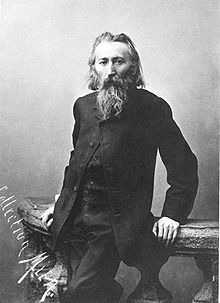
Back Jan Matejko AN يان ماتيكو Arabic جان ماتيجكو ARZ Yan Mateyko Azerbaijani Ян Матэйка Byelorussian Ян Матэйка BE-X-OLD Ян Матейко Bulgarian Jan Matejko Breton Jan Matejko Catalan Jan Matejko Czech
Jan Matejko | |
|---|---|
 Matejko, before 1883 | |
| Born | Jan Alojzy Matejko 24 June 1838 |
| Died | 1 November 1893 (aged 55) |
| Resting place | Rakowicki Cemetery, Kraków, Poland |
| Nationality | Polish |
| Other names | Jan Mateyko |
| Education | |
| Known for | Painting, drawing, teaching |
| Notable work | |
| Movement | History painting, academic art |
| Spouse | Teodora Giebułtowska |
| Awards | |
Jan Alojzy Matejko (Polish pronunciation: [ˈjan aˈlɔjzɨ maˈtɛjkɔ] ; also known as Jan Mateyko; 24 June 1838[nb 1] – 1 November 1893) was a Polish painter, a leading 19th-century exponent of history painting, known for depicting nodal events from Polish history.[2][3] His works include large scale oil paintings such as Stańczyk (1862), Rejtan (1866), Union of Lublin (1869), Astronomer Copernicus, or Conversations with God (1873),[4] or Battle of Grunwald (1878). He was the author of numerous portraits, a gallery of Polish monarchs in book form, and murals in St. Mary's Basilica, Kraków. He is considered by many as the most celebrated Polish painter, and sometimes as the "national painter" of Poland.[2][3][5]
Matejko spent most of his life in Kraków. He enrolled at the Kraków Academy of Fine Arts at age fourteen, where he studied under notable artists such as Wojciech Korneli Stattler and Władysław Łuszczkiewicz and completed his first major historical painting in 1853. His early exposure to revolutions in Kraków and the military service of his brothers influenced his artistic themes. After studying art in Munich and Vienna, he returned to Kraków and set up a studio. He gradually gained recognition, selling key paintings that settled his debts and created some of his most famous works, including Stańczyk and Skarga's Sermon. Matejko's art played a key role in promoting Polish history and national identity at a time when Poland was partitioned and lacked political autonomy.
At the same time, Matejko's painting style has been criticised as old-fashioned and overly theatrical, labeled as "antiquarian realism". His works often lost their nuanced historical significance when displayed abroad due to the audience's unfamiliarity with Polish history. Matejko's support for the Polish cause was not just through his art; he also contributed financially and materially to the January Uprising of 1863. Later, he became director of the art academy in Kraków, which was eventually renamed the Jan Matejko Academy of Fine Arts. A number of his students became prominent artists in their own right, including Maurycy Gottlieb, Jacek Malczewski, Józef Mehoffer and Stanisław Wyspiański. He received several honors during his lifetime, including the French Légion d'honneur. Matejko was among the notable people to receive an unsolicited letter from the German philosopher Friedrich Nietzsche, as the latter tipped, in January 1889, into his psychotic breakdown while in Turin.[6][7]
- ^ Maria Szypowska (2016). Jan Matejko wszystkim znany (in Polish). Fundacja Artibus-Wurlitzer oraz Wydawn. Domu Słowa Polskiego. pp. 7–8. ISBN 9788377858448.
- ^ a b Cite error: The named reference
TPaPwas invoked but never defined (see the help page). - ^ a b Cite error: The named reference
MioPawas invoked but never defined (see the help page). - ^ "Conversations with God: Jan Matejko's Copernicus, Exhibition, 21 May-22 August 2021". National Gallery London. 2021.
- ^ William Fiddian Reddaway (1971). The Cambridge History of Poland. CUP Archive. p. 547. GGKEY:2G7C1LPZ3RN.
- ^ Matejko Adressat des Briefes Den erlauchten Polen vom 4. Januar 1889 (in German)
- ^ Nietzsches Briefe, Ausgewählte Korrespondenz, Wahnzettel 1889
Cite error: There are <ref group=nb> tags on this page, but the references will not show without a {{reflist|group=nb}} template (see the help page).